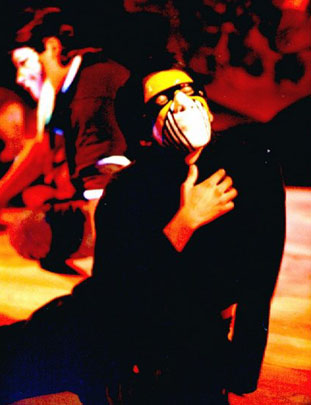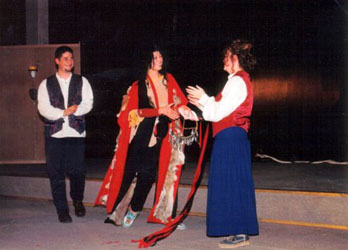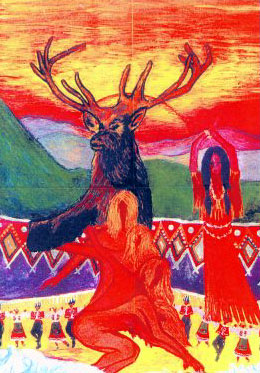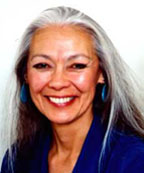|
We live in an age where cultural exchange and cultural divisions often go hand in hand. Witness the current events between the clash of cultures; events that dominate the news, our thinking, our fears, and perhaps, most of all, a certain weariness with how the common bonds of humanity, so desperately needed in a fragmenting world, seem, in these times, sorely tested. How do the performing arts cut across cultural boundaries and forge fresh relationships, through imaginative and transformational means? What are those time-honored performance pursuits of doing, becoming and revealing that work best cross-culturally? An answer often lies in small details that are singularly human and transformational.
I remember an incident that occurred at the College of Santa Fe where I was teaching Acting for the Camera. The course was exploratory and incremental, since the equipment we had was new, and the work we did was observationally based. Students were given exercises where they spoke to the camera directly, and later did scenes in the studio, or outside where students blended interviews with external events. The point was to explore shifting realities and keep on track in front of or behind the camera, while all the time picking up the know-how as we went along.
A Navajo student would not work in front of the camera. It took me awhile to figure out why this was happening. I thought the reason he refused to stand in front of the camera might be the usual ones of unfamiliarity, shyness, stage fright, of some combination there of. But I also had a hunch that there was more here than met the eye. Did he feel that the camera, and more importantly, the video tape was capturing his spirit? When he asked me if his father could attend the class, I replied sure, why not? When his father arrived and studied the situation, he became interested in the learning process of what we were doing. Afterwards we talked and he gave his son permission to work behind the camera as a technician. The young man later became involved in videotape editing and got to the point of interviewing another Indian student on camera. Eventually he stood in front of the camera and spoke about his experiences openly with a great deal of charm. The other students were supportive of his efforts and we all learned from him. We learned not to make immediate assumptions about why someone from a different cultural background might hesitate in a learning situation that is unfamiliar. Essential cultural beliefs sustain the integrity of communities and the uniqueness of an individual. Although the Navaho student may have never thought of himself as a teacher, he was, in a very real sense, both a student and a teacher. In my mind, students and teachers are often interchangeable.
I have worked with Daystar (Rosalie Jones), the Artistic Director of Daystar: Contemporary Dance-Drama of Indian America, since the early 90's. We have worked independently, teaching and creating performances on our own, and we have worked together, throughout the United States, Canada, and abroad. Here are her comments on cross-cultural collaboration:
Daystar: There are differing personal, cultural, artistic and educational "perspectives" in both the facilitator and the participant. How do collaborators create the bridge of mutual understanding that is necessary for successful work in the arts? From our experiences, we have learned that one becomes the "friend" when there is a willingness to truly see the other, and consciously make an exchange: a give and take between individuals. And the exchange must be not only of professional/academic/artistic knowledge, but also of cultural knowledge. The "foe" comes to the surface only as one gets in the way, refusing to allow this interchange between individuals and cultures. When the exchange is realized, personal and cultural understanding is achieved, and true honesty can take hold.
In 1989 I was hired by IAIA (Institute of American Indian Arts) in Santa Fe, to "revitalize" their performing arts program, make it a "Department," and achieve accreditation for a two year undergraduate degree. In the early 1990's, Ned Bobkoff was hired at the IAIA to teach performance and creative writing courses, help establish an acting program and coordinate the development of plays highlighting Native American concerns. It was also in 1990 that Congress passed the Native Graves Protection and Repatriation Act, which stated that human remains and objects found in Indian graves must be returned to their original owners (the tribes), thus reversing a century-old practice which turned native human remains into federal property.
Ned had started to write a play titled "Wild Water Running" for use in the student acting class. The dramatic line of the play centered on a fictional incident concerning a Hispanic contractor hired to clear ground for a high-speed reactor in the New Mexico. The contractor's men (both Hispanic and Native American) unearth not only low grade radiation and laboratory materials from Los Alamos, but the bones of ancient indigenous peoples as well. Enter the contractor's niece, a youthful but spiritually wounded Pueblo woman. The stage was set for a contemporary Antigone play: the confrontation of the niece and her uncle over the burial of relative's remains, contrasted with the needs of the workers to maintain their jobs.
 |
Ned: I approached acting students at the Institute of American Indian Arts with an outline and dialogue from "Wild Water Running." I told them that I knew little or nothing of their cultural heritage. All I had was a concern over the issue, based on my own outrage over incidents in France, where anti-semitic thugs were desecrating Jewish cemeteries. I felt completely over my head when it came to Pueblo tribal details and rituals, and the play was only a suggestion that the students could reject or work with as they saw fit. We read the play together. After a couple of sessions exploring and improvising around what I had written, they told me they wanted to work on it with me. The performers would fill me in on the accuracy of the cultural details. We dived right into the work together. Episodes of humor and satire, developed by the students, also contributed to the overall positive effect. I asked Daystar if she would choreograph the sequences in the play that were necessary to ground the work in indigenous tradition and then expand on it theatrically. We staged the play at a local Santa Fe performing arts center to an invitation-only audience of parents and indigenous peoples. "Wild Water Running" was well received. And I learned yet another lesson about protocol and good will: Do Unto Others As You Would Have Them Do Unto You.
THE BULGARIAN EXPERIENCE
Daystar: In 1995-96 Ned was hired as a Lecturer in Theatre Arts at the American University in Bulgaria, where he taught theatre arts and playwriting to students from 12 East European nations. Ned and his students staged plays, folk tales (Bulgarian and Korean), and mixed media events. I was invited as the "Distinguished Visiting Lecturer" to speak about and present Native American dance and culture. Little did I know that Bulgaria has a well-placed romantic regard for the Native American, generated perhaps by a reminiscence of their own tribal past. I did the usual workshops, lectures and master classes. A true cultural collaboration, however, was in the offering. Ned needed an end- of-the-semester dramatic work for his best students. I offered one of the stories of the trickster "Napi" from the Blackfeet, my birth country. This was not one of the comic trickster stories, but one of the more profoundly serious of the Napi stories: "The Origin of Death." A story about death as the signature moment of human existence. The performance became a collaboration of the highest order. I danced Napi as the alter-ego.
 |
Ned shaped the story into a play for the two main characters: Napi and his wife. The performance was delivered in the Bulgarian language, and eventually was presented at the American Embassy in Sofia, Bulgaria's capital. Napi had never traveled so far!
The summer of 1996 found us in Sliven, a gypsy town in a mountainous region of central Bulgaria. As a result of the American University experience, we were invited to create a "new" work at the Sliven Summer Theatre and University, with well-trained, experienced Bulgarian actors and dancers. What "new" work to do? Several stories were discussed, but the choice settled on was another Blackfeet story, "Scarface." This story I had previously written, choreographed and directed as a stage work to tour Montana for its Centennial in 1989. I knew the story thoroughly, also because it is the cornerstone tradition of the larger and very sacred Medicine Lodge Ceremony of the Blackfeet people.
Certain portions of the story cycle had already found their way into print, often-times told by Blackfeet people themselves to writers that they were well aware would publish the story. This is not to say that any story can be brought to the stage, or reinterpreted into another medium, at random. Utilization of any cultural story should rightfully, only be done after consulting with the proper cultural tribal authorities, whether that be elders, council members or sanctioned tribal storytellers. I had already gone through that process.
The actors were, to say the least, intrigued by a story from the Native Americans. We cast the show, then went into rehearsal. Finally, costumes were found in the cavernous basement of the Sliven State Theater (originally built and maintained by the Soviets while still in power). Each "period" had a separate gigantic room with row upon row of possibilities: Greek, Medieval, Shakespearean, contemporary, what? We settled on interpreting the "medicine woman" who gives Scarface a new handmade pair of moccasins for his journey, as a blind 'seer", complete with half mask and tattered gown. A young tall, sensitively alert young man became Scarface. Dancers became the townspeople who mock Scarface, and the flying cranes who save him from destruction was choreographed by well known Bulgarian choreographer, Boyana Setchanova. Because of the journey element in the story, we decided to stage the work in the theater lobby, which had 3 adjoining open rooms (one with a wondrous sun-like sculpture) and a spiraling staircase for the blind 'seer'. The audience followed the action. Later additional performances were developed with Bulgarian professional actors at the Varna International Theatre festival on the Black Sea.
The project successfully traversed a number of cultural and artistic hurdles. One hurdle was the language. I found that, rather than hinder the process, the time spent waiting to have what you just said, translated from English into Bulgarian, and the answer then given back from Bulgarian into English, gave everyone that all-too-precious element: time. We had time to look at each other and to register the reactions of each to the other. We had time to see eyes, read lips, gestures and body language in that human method of communication that preceded speech.
Two young Bulgarian choreographers came knocking on our "in-theater" lodging rooms in Sliven, three days and nights in a row. Katia Ivanova Tenava and Snejina Teneva Petrova were co-directors of the aptly named Wild Women Folk Dancers of Biala. The final night, they came bearing flowers. That did it. We were literally whisked up a mountain top to a little village called Biala. It would be the next summer before a creative project between us could be realized, thanks to a grant from Artslink, NYC (especially interested in cultural exchange in the Balkans). Ned would videotape the project.
One of my fondest memories of that summer in Biala is of bells tinkling in early morning light. It was the sheep being herded past the house, on their way to the fields for the day. Each evening, they returned, still ringing bells, in the evening dusk. Those sheep held the clue to a traditional Biala story we would choreograph together. We set to work in the town theater, small, badly in need of maintenance, but appreciated by all. The two Bulgarian choreographers, Katia and Snejina, wanted an artfully and culturally integrated approach to choreography, so that all three of us would jointly choreograph Bulgarian and Native American dance and stories in tandem. The Folk company showed their dances, steps and songs to me. I learned the Bulgarian step series, and then set to teaching Native American Intertribal Dance. Eventually, the women's Shawl Dance and Swan Dance would be choreographed for the girls of the Folk Company. A particularly thrilling moment ensued during rehearsal: all three of us agreed to "try" Bulgarian steps set to a traditional Native American powwow song. It was to say the least, unheard of; hesitantly at first, but then with gusto, the lead male Bulgarian dancer realized that the tempo and rhythms were the same. We had found another inroad to bridging the cultural gap.
Katia and Snejina led me to the hill just outside of the village. Standing there was "the tree" struck by a massive bolt of lighting, a sign from God that they had transgressed an ancient rule of hunting: always let the first deer live. Kill the second deer for food. The tally of the taboo was that deer would never come to Biala again; they would raise sheep for their livelihood. All of us gasped in recognition. I also knew a "deer story" from the Americas, in which the bones of the deer taken in the hunt, must be thrown into the water, so that the Spirit of the Deer can be released and reborn again, thus continuing to feed the people. We would present "Bones" and "The Spirit of the Deer," in a cultural exchange in dance, song, music and story, on the stage of a little theater on a mountaintop in Bulgaria. Even the Peace Corps representatives from Sliven showed up, but I will never forget the bright eyes and expectant smiles of the grandmothers, grandfathers, parents, friends and relatives from the village whose presence filled the old theater to the top of the balcony that afternoon.
 |
Deer Legends. Bulgarian-Indian dance drama
THE TURKISH EXPERIENCE
Ned: In 1993-94 I was a guest director at the National Konservatuvari for Music and the Performing Arts on the Yunis Emre campus of Anadolu University in Eskisheir, Turkey. Yunis Emire is a famous Turkish folk poet, and the campus is located in Anatolia, the heart of Turkey – about half way between Ankara, the capital, and Istanbul. The theater students, age ranging from 18 to 31, were among the most passionate, idealistic and talented young performers I have ever worked with. Except for some basic every day expressions, I didn't know a word of Turkish. When I arrived I immediately set down with Erhan Tuna, a graduate student and my assistant director. We worked together on a translation of Friedrich Dirrenmatt's masterpiece, "The Visit" – a tragi-comedy and a parable on the illusionistic and destructive nature of greed. Working with performers without knowing their language provided unexpected opportunities to hit the target on cue. Cultural differences often give away to mutually shared expressions of behavior, the visual cues and calculated rhythms of rehearsals, and the sense and sensibility of creative exchange. Erhan Tuna told me that I was usually in the range of one or two lines when I commented on a scene between the actors.
 |
Rehearsal of "The Visit"
The Visit" later was invited to the Istanbul International Theatre Festival, at a theater on the Asian side of the Bosphorus, playing to a large, appreciative audience.
The International Theatre Institute had invited Daystar to perform at the Yildiz Palace Theatre in Istanbul. After a brief lecture, Daystar elected to dance her signature work: "Wolf: A Transformation". Using masks, up beat Native American music, and intricately realized transformational states of being, "Wolf" is a highly theatrical comment on the unity of original man with the living creatures of this world. I was then asked to comment on my work with Daystar. As a third generation American, I said to the audience, it is a privilege and honor to introduce the work of a First American. When people applauded I turned back towards the stage to see if Daystar had appeared. I was to cue the music for the dance presentation. Refik Erduran, the director of the International Theatre Institute, told me that the audience was applauding my introductory remarks. I was stunned. Apparently the Turkish audience has a special sensitivity to cultural values, and they recognize it when they heard it. After Daystar's performance of the Wolf dance, which had captured the audience's hearts, we were treated to a memorable round of sight seeing and food tasting throughout Istanbul; a full measure of cross-cultural hospitality and friendship!
DENISON UNIVERSITY, GRANVILLE, OHIO
Daystar: It is true that artistic, and teaching abilities no less, need an expressive vehicle. Without the vehicle, the spirit of the idea doesn't move. Over the years I developed a kind of "method" for teaching Native American dance (via the culturally-encompassing Intertribal Dance Forms) to non-natives as well. This process came full circle in a semester residency at Denison University in Granville, Ohio. Although it is still a rarity for a university dance curriculum to offer a single course in "World Dance," it is even more rare that in one university, a bonified major or minor in "World Dance" would be certified. Such is the case at Denison University Dance Department, where I taught Native American Dance in the Fall of 2004. There was not one native person in my classes. However, these aspiring western, mainstream dancers "took to" the repetitive, aerobic, and often times technical aspects of Native American dance. I teach these dances as they have become standardized in the unique step patterns, body postures, floor patterns and regalia of the Intertribal dance forms now practiced in the contemporary Powwow circuit. But here any similarities to western "modern dance" ends abruptly. No one dancing Intertribal can dance only for technique, or only for "show" or only for self. If it is anything at all, Intertribal Dance is the expression of the collective culture of the community, in its regalia, in its protocols and etiquettes, in its songs, and in the spirit present when one dances.
Yes, those thirty dance majors and minors and elective students did learn to dance Intertribal. But they learned much more. Beyond the steps and the regalia (cultural term for dance apparel), they learned traditional singing, the instances in which one would dance, or not dance and why and why not, and what one dances about. They also learned the specific tribal culture from which a dance originated, where that nation is located geographically, what its history is now and has been in the past, and what it expects as a future. The etiquettes of dancers and dancing in native communities take a lifetime to learn. In one semester, the teacher, facilitator, choreographer can only provide an entry way to learning,. In turn, the student, recipient, dancer, performer can open his or her eyes to a new culture with earned confidence and a multitude of respect.
The Denison University students finished the year with a performance of Intertribal Women's Shawl Dances, Men's Grass Dances, the spectacular and intricate Hoop Dance, the community Round Dances, as well as contemporary choreography based on native storytelling. I have reason to believe that the experience was one they will remember for a lifetime. They had made a beginning of learning and respecting cultures from the inside out – from the body to the mind and finally, to the spirit, with respect for the dance forms, but more importantly, with respect for the people from whom the dances originated. In short, dance frequently teaches what words cannot.
Ned: Performance has something to do with learning from experience and using what you've learned to grow into some one you have never been before. It is not "make believe," a magic formula, a systematic collection of effects, a superimposition of behavior, or a rigid, previously grounded concept. It is a process done by this person, in this time and place, with these means, and, at the same time, revealing someone we recognize. The experience of the "someone we recognize" reveals our common bonds of humanity, and is at the heart of cross-cultural exchanges. It can happen in surprising incidents and unadulterated experiences, in any form – and it does – for better or worse.
In a time when political leaders are sorely tested, populations around the world see the performing arts, for the most part, as a frill, or a way of getting away from it all. Those of us who still have some power over on how people will respond to what we do, know better. And that's the way it should be: No Audience Left Behind. We are all in the same boat.
 
|